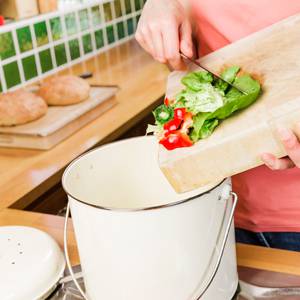Any gardener knows that composting is the single best way to provide your garden with nutrients.
Did you also know that household composting is becoming mandatory all over the world? Now might be the time for you to learn how to start composting on your own!

- Compost is an all-natural, cheap, and effective way to add nutrient-rich humus to depleted soil to restore its vitality and encourage healthy plant growth.
- Compost diverts as much as 20%-30% of household waste away from the bin, which reduces to as much as 15% percent off from the nation's municipal solid waste (MSW) stream.
- Any kitchen or yard waste such as meal leftovers, fruit and vegetable peelings, coffee grounds, egg shells and any kind of food scrap can ALL be made into compost.
- Compost is a very environmental-friendly option to chemical fertilizer – zero toxins to plants, soil and water.
One-third of North America landfills are made up of compostable materials and many have closed down. It’s about time to turn to composting.
5 Simple Steps:
 Whether you opt for fast or slow composting, the ideal size for a compost bin is 3 feet high, 3 feet wide, and 3 feet deep. Make sure all sides are ventilated for better air circulation. For fast compost, you can build the layers all at once to fill the bin in no time at all, ready to use after a few months. For slow compost, build your pile over time which would make it ready in no less than a year.
Whether you opt for fast or slow composting, the ideal size for a compost bin is 3 feet high, 3 feet wide, and 3 feet deep. Make sure all sides are ventilated for better air circulation. For fast compost, you can build the layers all at once to fill the bin in no time at all, ready to use after a few months. For slow compost, build your pile over time which would make it ready in no less than a year.- Chop materials first before you put it into the bin. The smaller the particles the faster the decay time. Brown materials should go first, on the bottom of the pile. These include dead grasses, chopped leaves, small sticks, newspapers, wood chips/pellets and coffee grounds or tea leaves.
- Alternate green materials with brown materials. Fruit and vegetable peelings as well as fresh grass clippings are nitrogen-rich which will balance the carbon-rich content of the brown materials in the bin. End the layering process with a light layer of soil.
- After the layering process, water everything down. Keep it moist but not too wet to encourage decay process. Covering the pile is a must – to avoid it from getting soppy wet if you live in a very wet climate or to avoid it from drying out too fast if you live in a very hot area.
- For faster compost, turn your pile on a regular basis. If it makes it difficult, try dividing the compost into several bins. The more often you turn the pile, the hotter it will get – which will deter any weed seed growth. Different materials used as compost will decompose at varying rate or speed but they will all break down eventually.
Composting myths:
- Compost stinks. No, it doesn’t. As long as you don’t add animal products such as meat and dairy, your compost should smell earthy like the forest. Incidentally, putting in green materials will produce an unpleasant odor especially during rainy season. But by adding a layer of soil on top of it, the smell will go away.
- Animals are attracted to compost. Not all the time. Again, as long as there are no animal products added, it won’t be a breeding ground for insects and rodents.
- Compost requires a lot of space. Not really. Even if you only have a small tumbling bin or a plain garbage bag with air holes, you can compost even for people who live in small apartments or condominiums.
- Compost needs special activators or starters. This is not a necessity and you won’t miss out on anything even if you don’t add one. Materials that activate compost are leftover compost from a previous pile and rabbit food (alfalfa pellets).
- Compost takes a lot of time and effort. Lazy composters just mix it up, wet it through, and turn it once in a while. Nature does the rest. How hard it can be?
There are many more things happening with organic trash. The State of California is leading the way. Here's a short article on some of the ways organic materials are being recycled.













Write a Comment